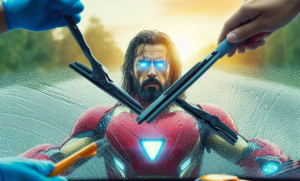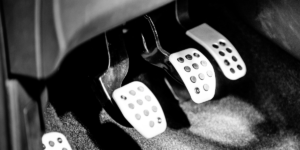Which side is the passenger on? A lot of people have asked it, but not many can give the right answer. It really does depend on the country you’re in. The left side of the car is for the driver and the right side is for the passengers. On the other hand, the driver’s side is on the right in the UK, Australia, and Japan, while the passenger side is on the left.
So, why does this happen? Does it really matter?
We’ll talk about the past of right- and left-hand drive and the pros and cons of each in this blog post. There’s also the question of whether the side of the car you’re sitting on really does matter.
This easy trick will help you remember:
You get into the car as a passenger on the passenger side.
If you’re not sure which side of the car is the passenger side in a right-hand drive country, this trick will help you a lot. Not only does the front passenger seat sit on the passenger side, but this is also the side of the car where people get in and out. That being said, most cars have a bigger and more comfortable front passenger seat than the driver’s seat. The reason for this is that riders stay in their seats longer than drivers do.
As you enter the car, the front passenger door is on the side that seats the passenger. The front door for the passenger is usually bigger and easier to open than the door for the driver. There are more times when people need to get in and out of the car than when the driver does. If you know which side of the car is the passenger side, you can show off your car and driving skills to your family and friends.
The history of right- and left-hand drive
Right- and left-hand drive date to the Roman Empire. People across Europe drove on the left for hundreds of years, including Romans. The UK adopted right-hand drive in the 18th century. People in different nations drive on opposite sides for many reasons. Most Romans are right-handed, hence some historians believe they moved left. Righties could easily mount and dismount horses on the left side of the road.
They believe the varied driving sides are due to how forces marched into battle. Middle Ages armies marched on the right so right-handed troops could use their swords more easily. Sometimes armies marched on the left side of the road so left-handed warriors could utilize their shields more easily. Drive sides also affect the economy. In the 1700s, the UK switched to right-hand drive to ease trade with Europe. Horse-drawn wagons carried a lot of UK-Europe trade. The left side of the road allowed cart drivers to observe more traffic approaching the other way, making it easier to pass.
Today, most countries drive on the right. Left-hand driving is still common in the UK, Japan, and Australia. Driving on the other side may be difficult for people used to it. Careful practice can help you adjust to driving on the other side.
Why is the driver’s side on the left or right in different countries?
In each country, the driver’s side is not the same as the side of the road where most people drive. Several things, like history, tradition, geography, trade, and military tactics, have led to this. In the past, Romans drove on the left side of the road, and people all over Europe did the same for hundreds of years. Some countries, like the UK, moved to right-hand drive in the 18th century.
Some other things that can affect which side of the road people choose to drive on are:
- Why do people drive on the left side of the road in hilly areas? It’s easier for drivers to see other cars coming.
- When it comes to trade, countries can move to the same side of the road as their main business partners.
- In the Middle Ages, armies marched on the right side of the road so that men who were right-handed could use their swords more easily. But in some places, armies marched on the left side of the road so that men who were left-handed could use their shields more easily.
What are the pros and cons of having the driver’s side on the left or right?
Pros of having the left side of the car for the driver:
- When stopped on a busy street, it’s easier to get in and out of the car from the passenger side.
- It’s easier for the driver to see approaching cars, especially in hilly or mountainous areas.
- For trade with countries where people drive on the left, this is better.
Cons of having the left side of the car for the driver:
- On a two-lane road, it’s harder to get around cars going the other way.
- Not as easy to move onto a highway.
- Parallel parking spots are harder to get into and out of.
Pros of having the right side of the car for the driver:
- A two-lane road makes it easier to pass cars coming the other way.
- It’s easier to get on a highway.
- Parallel parking spots are easier to use.
Cons of having the right side of the car for the driver:
- If you park on a busy street, it’s harder to get in and out of the car from the passenger side.
- More difficult for the driver to see oncoming cars, especially in places with mountains or hills.
- It’s not as easy to do business with places where people drive on the left.
Ultimately, the pros and cons of having the driver’s side on the left or right rely on many things, such as the country’s geography, its trading partners, and its traditions and customs.
How to adjust to driving on a different side of the road?
Adjusting to driving on the opposite side of the road can be challenging, but it is possible with a little care and attention. Here are some tips:
- Plan your journey in advance. This will give you a chance to familiarize yourself with the route and to identify any potential hazards.
- Allow extra time for your journey. You may need to drive more slowly and cautiously until you adjust to driving on the opposite side of the road.
- Be aware of your surroundings. Pay attention to oncoming traffic, pedestrians, and cyclists.
- Use your mirrors regularly. This will help you to check for blind spots and to see oncoming traffic.
- Be extra careful when turning and merging. Take your time and make sure that it is safe to do so before proceeding.
- Don’t be afraid to ask for help. If you are unsure about anything, ask a local for directions or assistance.
- Choose a quiet road to practice on. This will give you a chance to get used to driving on the opposite side of the road without having to worry about other traffic.
- Take a passenger with you. A passenger can help you to navigate and can also keep an eye out for oncoming traffic.
- Use a GPS device. A GPS device can help you to stay on the correct side of the road and to avoid making any wrong turns.
- Be patient. It takes time to adjust to driving on the opposite side of the road. Don’t be discouraged if you make a few mistakes at first.
With a little care and attention, you will be driving on the opposite side of the road like a pro in no time!
Fun facts about right- and left-hand drive cars
Here are some interesting facts about cars that drive on the right or left:
- Most cars drive on the right side of the road, but some countries, like the UK, Japan, and Australia, drive on the left.
- Karl Benz built the first car in 1886. It was a left-hand drive car. In the early 1900s, though, right-hand drive cars became more common because they made it easier to load and unload people at the curb.
- People in the UK moved to right-hand drive in the 1700s because it made trade with Europe easier.
- After the United States took over Japan in 1946, they moved to left-hand drive.
- Australia changed from right-hand drive to left-hand drive in 1971 so that it could make cars that would sell in Japan.
- There are some places in the world where the left side of the road still works. One country that changed from left-hand drive to right-hand drive was Sweden in 1967.
- Sometimes there are both left-hand drive and right-hand drive cars in the same country. As an example, cars can be driven on either the left or the right side in Cyprus.
- Because they are made in smaller numbers, right-hand drive cars cost more than left-hand drive cars.
- Some people think that because the driver is closer to the middle of the road in a right-hand drive car, it is better than a left-hand drive car. There is, however, no scientific proof to back up this claim.
I hope you liked these interesting facts about cars that drive on the right or left.
The future of right- and left-hand drive
Right- and left-hand drive may not be around for much longer. Different experts have different ideas about whether the world will finally only drive on one side of the road or whether right- and left-hand drive will continue to coexist.
There are several things that could change the future of right- and left-hand drive, such as:
- Global trade: As trade around the world grows, countries may decide to drive on the same side of the road as their key trading partners to make it easier for everyone to do business.
Changes to one side of the road could also be caused by progress in technology, like cars that drive themselves. Self-driving cars could be set up to go on either side of the road, but it would be easier for everyone if everyone went on the same side. - Some experts think that right-hand drive cars are better than left-hand drive cars because the driver is closer to the middle of the road. This could cause more countries to switch to right-hand drive if it’s true.
There are, however, a number of reasons why right- and left-hand drive might never go away. One reason some countries might not want to switch lanes is that it might be expensive and cause problems. In some countries, driving on the left side of the road may also have cultural or historical roots.
In the end, it’s not clear what will happen with right- and left-hand drive. One side of the road might become the norm for the whole world, but it’s also possible that both right- and left-hand drive will continue to exist.
What are some other names for the passenger side of the car?
The passenger side of the car is also sometimes referred to as the:
- Nearside (in the United Kingdom and some other countries)
- Offside (in the United Kingdom and some other countries)
- Right-hand seat (in countries where the driver’s side is on the left)
- Left-hand seat (in countries where the driver’s side is on the right)
Passenger side is Left or Right is different countries
Here is a list of countries where the passenger side is on the left or right,
| Left-hand drive | Right-hand drive |
|---|---|
| Antigua and Barbuda | Anguilla |
| Argentina | Australia |
| Bahamas | Bangladesh |
| Barbados | Barbados |
| Bahrain | Belize |
| Bangladesh | Bermuda |
| Barbados | Bhutan |
| Belarus | Botswana |
| Belgium | British Virgin Islands |
| Belize | Brunei |
| Bermuda | Cayman Islands |
| Bhutan | Cook Islands |
| Botswana | Cyprus |
| Brunei | Dominica |
| Cayman Islands | East Timor |
| Chile | Falkland Islands |
| China | Fiji |
| Colombia | Grenada |
| Congo | Guernsey |
| Costa Rica | Guyana |
| Croatia | Hong Kong |
| Cuba | India |
| Cyprus | Indonesia |
| Czechia | Ireland |
| Denmark | Isle of Man |
| Dominican Republic | Jamaica |
| Ecuador | Japan |
| Egypt | Jersey |
| El Salvador | Kenya |
| Estonia | Kiribati |
| Eswatini | Lesotho |
| Ethiopia | Macau |
| Faroe Islands | Malawi |
| Finland | Malaysia |
| France | Maldives |
| Georgia | Malta |
| Germany | Mauritius |
| Ghana | Montserrat |
| Gibraltar | Mozambique |
| Greece | Namibia |
| Grenada | Nauru |
| Guam | Nepal |
| Guatemala | New Zealand |
| Guyana | Norfolk Island |
| Haiti | Niue |
| Honduras | Northern Mariana Islands |
| Hong Kong | Oman |
| Hungary | Pakistan |
| Iceland | Palau |
| India | Papua New Guinea |
| Indonesia | Pitcairn Islands |
| Iran | Qatar |
| Iraq | Saint Helena, Ascension and Tristan de Cunha |
| Ireland | Saint Kitts and Nevis |
| Isle of Man | Saint Lucia |
| Israel | Saint Vincent and the Grenadines |
| Italy | Samoa |
| Jamaica | Saudi Arabia |
| Japan | Seychelles |
| Jersey | Sierra Leone |
| Jordan | Singapore |
| Kazakhstan | Sint Maarten |
| Kenya | Solomon Islands |
| Kiribati | South Africa |
| Kuwait | South Korea |
| Kyrgyzstan | Sri Lanka |
| Laos | Suriname |
| Latvia | Swaziland |
| Lebanon | Sweden |
| Lesotho | Switzerland |
| Liberia | Syria |
| Libya | Taiwan |
| Liechtenstein | Tanzania |
| Lithuania | Thailand |
| Luxembourg | Togo |
| Macau | Tokelau |
| Macedonia | Tonga |
| Madagascar | Trinidad and Tobago |
| Malawi | Turkey |
| Malaysia | Turks and Caicos Islands |
| Maldives | Tuvalu |
| Malta | Uganda |
| Marshall Islands | United Arab Emirates |
| Martinique | United Kingdom |
| Mauritania | United States Virgin Islands |
| Mauritius | Uruguay |
| Mayotte | Uzbekistan |
| Mexico | Vanuatu |
| Micronesia | Venezuela |
| Moldova | Vietnam |
| Monaco | Yemen |
| Montenegro | Zambia |
| Montserrat | Zimbabwe |
Please note that this list is subject to change, and there may be some countries where the passenger side is on the opposite side of the road from what is listed above. It is always best to check the local traffic laws before driving in a new country.
FAQs about is the passenger side right or left
Q: Is it easy to switch from driving on the left-hand side of the road to the right-hand side of the road, and vice versa?
A: Switching from driving on the left-hand side of the road to the right-hand side of the road, and vice versa, can be challenging, but it is possible with a little care and attention.
Q: Which side is the passenger side of the car?
A: The passenger side of the car is the side of the car that is opposite the driver’s side. In most countries, the driver’s side is on the left and the passenger side is on the right. However, there are some notable exceptions, such as the United Kingdom, Japan, and Australia, where the driver’s side is on the right and the passenger side is on the left.
Q: What are some cultural differences in how people refer to the passenger side of the car?
A: There are a number of cultural differences in how people refer to the passenger side of the car. In most countries, the passenger side is simply referred to as the “passenger side” or the “passenger seat.” However, in some countries, there are other names for the passenger side.
For example, in the United Kingdom and some other countries, the passenger side is sometimes referred to as the “nearside” or the “offside.” The nearside is the side of the car that is closest to the curb, while the offside is the side of the car that is farthest from the curb.
In countries where the driver’s side is on the left, the passenger side is sometimes referred to as the “right-hand seat.” In countries where the driver’s side is on the right, the passenger side is sometimes referred to as the “left-hand seat.”
Here is a table of some common names for the passenger side of the car in different countries:
| Country | Name for the passenger side |
|---|---|
| United Kingdom | Nearside, offside |
| Australia | Passenger side, passenger seat, right-hand seat |
| Japan | Passenger side, passenger seat, left-hand seat |
| United States | Passenger side, passenger seat |
| Canada | Passenger side, passenger seat |
Conclusion
Last but not least, the side of the road that people drive on is a matter of tradition. You can drive on any side of the road. There are pros and cons to driving on the left or right side of the road that depend on many things, such as the country’s geography, its trading partners, and its traditions and practices. If you are going to a place where the driver’s side of the road is different from where you are used to, you should be extra careful and give yourself some time to get used to the new rules. If you pay close attention, you’ll be able to drive on the other side of the road in no time!








